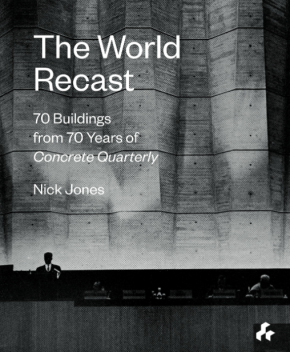The World Recast: 70 buildings from 70 years of Concrete Quarterly
The World Recast: 70 buildings from 70 years of Concrete Quarterly, Nick Jones, Artifice, 2018, 237 pages, extensive number of black & white and colour illustrations.
As an architecture student in the late 1960s, I well remember the excitement of seeking out the latest issue of Concrete Quarterly in the college library every four months. This may seem an anorakish enthusiasm for what was essentially a building trade magazine, but Concrete Quarterly was (and remains) different. First, reinforced-concrete construction was the essential material for post-war reconstruction; it allowed large-scale developments such as power stations, exhibition halls, theatres and office blocks to be built with maximum speed and efficiency.
More important, the capacity for the material to be moulded to any shape gave it huge sculptural possibilities, which were exploited by great and inspiring architects and engineers such as Le Corbusier, Pier Luigi Nervi and Oscar Niemeyer to create buildings of striking design. Ove Arup built a rubber factory in Wales (now alas demolished, in spite of being Grade II* listed) that was described as ‘a floating ship of luminosity in space and sky’.
The journal’s success was due to two exceptional editors from its inauguration in 1947 until 1986. The first was the formidable Betty Campbell, who had worked for the Free French during the war, and afterwards for the War Crimes Commission. With an ambition to record the finest architecture of the period, she informed and inspired readers to appreciate the technical and aesthetic capability of the material, set up overseas visits for British architects, and brought eminent designers, including Felix Candela, to lecture in Britain.
She was succeeded in 1965 by George Perkin, who was equally forthright and deplored the lack of regard for high-quality British architecture, as well as questioning the social impact of high-rise housing in Britain from an early period. Perkin was also an accomplished photographer, whose images were published in Concrete Quarterly alongside those of established masters such as Richard Einzig and John Donat.
Nick Jones, author of The World Recast, became editor in 2011 and has followed in the footsteps of his earlier predecessors. His book presents a survey of exceptional modernist architecture, setting out its social and political context over the past 70 years based on the archives of the journal. It features a roughly equal number of British and overseas buildings, accompanied by top-class photographs. Of the selected British buildings up to and including the 1980s, most have now been listed, while some, such as St Peter’s Seminary outside Glasgow and Dunelm House, Durham, are at serious risk. Another problematic building, Park Hill, Sheffield, was not featured when it was completed in the 1960s, but the successful refurbishment and conservation of phase one by Urban Splash appeared in the journal in 2011 and is also included in the book.
Concrete has made a comeback in recent years and is once again a popular choice for architects and clients. But it is now coming under fire for its environmental shortcomings, and it will be interesting to see how this essential and often beautifully crafted material will be adapted to suit a world with different priorities.
This article originally appeared as ‘Sculptural possibilities’ in IHBC's Context 161 (Page 59), published by The Institute of Historic Building Conservation in September 2019. It was written by Peter de Figueiredo, heritage consultant.
--Institute of Historic Building Conservation
Related articles on Designing Buildings Wiki
IHBC NewsBlog
Old Sarum fire in listed (& disputed) WW1 Hangar - Wiltshire Council has sought legal advice after fire engulfed a listed First World War hangar that was embroiled in a lengthy planning dispute.
UK Antarctic Heritage Trust launches ‘Virtual Visit’ website area
The Trust calls on people to 'Immerse yourself in our heritage – Making Antarctica Accessible'
Southend Council pledge to force Kursaal owners to maintain building
The Council has pledged to use ‘every tool in the toolbox’ if urgent repairs are not carried out.
HE’s Research Magazine publishes a major study of the heritage of England’s suburbs
The article traces the long evolution of an internal programme to research 200 years of suburban growth
IHBC Context 183 Wellbeing and Heritage published
The issue explores issues at the intersection of heritage and wellbeing.
SAVE celebrates 50 years of campaigning 1975-2025
SAVE Britain’s Heritage has announced events across the country to celebrate bringing new life to remarkable buildings.
IHBC Annual School 2025 - Shrewsbury 12-14 June
Themed Heritage in Context – Value: Plan: Change, join in-person or online.
200th Anniversary Celebration of the Modern Railway Planned
The Stockton & Darlington Railway opened on September 27, 1825.
Competence Framework Launched for Sustainability in the Built Environment
The Construction Industry Council (CIC) and the Edge have jointly published the framework.
Historic England Launches Wellbeing Strategy for Heritage
Whether through visiting, volunteering, learning or creative practice, engaging with heritage can strengthen confidence, resilience, hope and social connections.
















